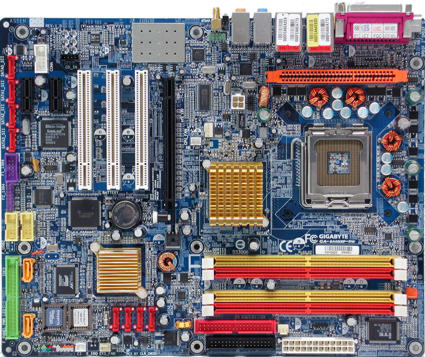Market Survey, Part 2: Six Premium Pentium 4 LGA775 Boards
Conclusion: Asus And Gigabyte Neck And Neck
The Gigabyte GA-8AENXP-DW, winner of our Editor's Choice award.
Intel's D925XECV2 is a good foundation for this group of boards. It is a high-quality board and well-equipped in its own right, boasting an interface module that installs into a drive bay. True enthusiasts however would no doubt appreciate more overclocking freedom, and additional mass memory controllers. It interesting to note that Intel's is one of the few boards to still offer four PCI slots.
MSI has spent too much effort on marketing the 925XE Platinum instead of refining the product. The features are without question very good, as MSI did think to put on a second network chip, FireWire, and an additional UltraATA controller. If you want to use MSI's proprietary CoreCell system for dynamic overclocking or do without overclocking, you will find MSI offers good value. We must reiterate though that detail and performance lovers should look elsewhere.
That leaves Asus and Gigabyte. With the Asus P5GDC-V Deluxe you get an attractively-priced, high-quality board from an acclaimed manufacturer. The product seems well-suited for upgrading with FireWire and an extra UltraATA controller, along with support for DDR2 and DDR400. Gigabyte's more sparsely equipped 925XE motherboard, the 8I925XE-G, may represent a low-cost route into the FSB1066 league, but it didn't always run stably in the test.
With the high-price-tag boards on the market things are quite different. The Asus P5AD2-E addresses nearly any imaginable desire of the high-end user. Support for up to 14 drives, FireWire, 802.11b/g WLAN, HD audio, and exemplary overclocking on top of a 100% smoothly running board certainly make it worth recommending. There is even an old game port thrown into the bargain for those who may need one, as well as the option of running a SATA drive externally, even if this is an untidy solution.
Leave it to Gigabyte with its GA-8AENXP-DW to really pile on the value, with a dual-channel WLAN at 108 MBit/s and the better antenna solution for instance. In addition there's the familiar dual BIOS as a system fallback, and a SATA II controller plus UATA to SATA converter. Gigabyte furthermore plays fair and doesn't overclock its board at the factory; the included accessories make everything that has gone before it pale by comparison. Those who want everything will be pleased with Gigabyte. It therefore gets our Editor's Choice award. However, it looks like this particular motherboard is already end of production ny now (May 2005).
These last two boards are quite pricey though. If you don't want to open up your wallet too wide, we recommend considering a board from the first part of this test .
Get Tom's Hardware's best news and in-depth reviews, straight to your inbox.
Current page: Conclusion: Asus And Gigabyte Neck And Neck
Prev Page Applications
Patrick Schmid was the editor-in-chief for Tom's Hardware from 2005 to 2006. He wrote numerous articles on a wide range of hardware topics, including storage, CPUs, and system builds.

